Body Butter hydrates softens and revitalizes skin for a radiant glow. Apply after showering when the skin is damp to moisturize and lock in hydration deeply.

Look for a formula that is rich in shea, cocoa, and mango butter, as well as nourishing oils. You may also like a butter that contains squalane, which helps skin retain moisture. Visit https://www.thelittlehomesteadco.com/ for more details.
Shea butter is derived from the nuts of the shea or Karité tree (Vitellaria paradoxa) that grows in West Africa. It’s a versatile ingredient that is an excellent moisturizer and offers skin a boost of antioxidants, healthy fats, vitamins E and A, and phytosterols. It is also known for its soothing and calming effects.
In addition to hydrating and moisturizing, shea butter has anti-aging properties as well as other benefits such as being an effective treatment for itchy skin and reducing dark spots. It also helps relieve dry, irritated skin caused by sunburns or wind burn.
Its fatty acid composition is unique: it has oleic, stearic, palmitic, and linolenic acids which make it highly emollient and a good source of skin-nourishing Vitamin E. Its linolenic acid content is especially beneficial for the skin because it can help prevent premature aging and sun damage by protecting the epidermis from UV rays.
When selecting shea butter, look for organic and fair trade certifications which ensure that the shea is ethically harvested and produced. Choosing shea butter sourced from reputable producers can also help support sustainable development and economic empowerment for women in the communities where it is harvested.
Because shea butter is solid at room temperature, it’s best to use in products with other oils and butters that have a lower melting point to create a balanced formula that won’t be grainy when applied to the skin. When shea butter is added to a formulation, it’s important to stir continuously to trace as this helps the shea melt and blend evenly. Stirring can also help minimize graininess when using shea in emulsions like lotions and creams as this technique encourages the shea to cool evenly which is an important factor in preventing it from forming grainy clumps.
Shea butter may also be useful for reducing joint pain as shea contains many antioxidants and is thought to have anti-inflammatory properties. Research suggests that shea butter can reduce underlying inflammation in the joints and even help heal the wounds that cause arthritis by speeding up the tissue remodeling process.
Organic Cocoa Butter
Cocoa butter is pressed from the seeds of the cacao tree. It has a solid texture at room temperature, but melts at body temperature making it a popular ingredient in lotions, soaps, and creams. It also helps give products a creamy consistency. Cocoa butter is a good source of antioxidant Vitamin E and fatty acids that help soothe skin, reduce dryness, and moisturize. It can be used on its own, but often is mixed with other ingredients to create a variety of products, including whipped body butters, lotion bars, and other skincare ointments.
It is a great natural emollient and can help with dry skin, especially in the winter time. It can be added to other oils like jojoba oil, almond oil, or even to your favorite lip balm to make it softer and more moisturizing. Cocoa butter is also a good source of antioxidants which can help fight signs of aging such as wrinkles.
You can find cocoa butter at many health food and specialty grocery stores as well as online. Look for pure, organic cocoa butter that is labeled as “food grade” and avoid products that are not safe to eat. You can also purchase it at many drug stores and vitamin shops as long as you read the labels carefully.
Our raw cocoa butter is organically grown, unrefined and comes in a 16 oz jar. It is free from chemicals and pesticides. It has a chocolate scent and can be used as a lip balm or in skin care products. It is a natural skin emollient and is a great moisturizer for all skin types. It can also be used to smooth and reduce the appearance of stretch marks.
It is also known to heal small burns, scars and cuts. It has a high concentration of antioxidants and fatty acids that deeply penetrate the skin and help to moisturize it. It can be used as a natural replacement for many commercial hydrating lotions, and is less irritating than those made with additives like fragrances and dyes. It can also be used to help soothe irritated or rashy skin and is a good lubricant for massages.
Organic Mango Butter
Mango butter is another highly moisturizing butter that’s similar in texture to Shea and Cocoa butter. This butter is also a wonderful choice to include in body lotions, soaps, and hair products. Mango butter is made from the seeds of a mango fruit. It’s hard at room temperature but melts easily on contact with the skin, making it an excellent substitute or addition to organic shea and Cocoa butters in body butters and creams.
It is a great option for people with sensitive skin because it doesn’t have an overwhelming scent like some other butters on the market. It is usually odorless, but sometimes it can have a slight mango scent. Like all our organic butters, our unrefined mango butter is free of chemicals and is non-comedogenic.
This butter has a high content of oleic and stearic acids, which makes it very easy to spread on the skin. Its anti-inflammatory properties make it very soothing for irritated skin, and its antioxidants help to protect the skin from sun damage. It is also known to reduce the appearance of fine lines and wrinkles and increase elasticity in the skin.
Mango Butter also has a high level of Vitamin C, which helps to promote collagen formation and decrease the appearance of scars and blemishes. It’s also a great moisturizer for the scalp and hair, and helps to fight frizz. It’s also a great ingredient for nourishing the skin and helping to soothe eczema, psoriasis, acne, minor cuts, and scars.
Mango butter is a deliciously soft and smooth butter that can be used as a substitute for Cocoa or Shea butter in any recipe. It can also be used as a stand-alone moisturizer for the skin or hair. The light, refreshing fragrance of this natural butter makes it a popular choice for aromatherapy recipes as well.
Organic Coconut Oil
Coconut oil is a favorite ingredient in many recipes and beauty products. Ours is organic, expeller-pressed and unrefined, delivering a light texture with a tropical aroma. Its high smoke point and light flavor make it a versatile cooking oil, but it is also excellent as a natural moisturizer and skin care product.
We use it in combination with shea butter and jojoba oil to create this creamy, all-natural body butter recipe. It’s easy to make and works great as a daily moisturizer for the whole body. The fatty acids in coconut oil help to promote healthy and hydrated skin. It’s an excellent choice for dry skin, including elbows and knees. You can even use it as a hair mask to prevent frizz and flyaways!
This easy, homemade body butter recipe is also an amazing DIY gift for anyone on your holiday list. Wrap it up in a cute jar with a ribbon and you have a fun, homemade gift they’ll love to use!
As with all fats, coconut oil has a high saturated fat content. However, unlike other saturated fats such as animal fats, the fatty acids in coconut oil are mostly medium chain triglycerides (MCTs). MCTs are metabolized more quickly than other fats and can provide instant energy for the body. They’re also thought to improve lipid profile and reduce insulin resistance.
In addition to boosting skin health and helping with weight loss, the MCTs in coconut oil may contribute to improved mental alertness. It’s also believed to protect the body from infection by blocking harmful microbes and enhancing wound healing.
Because it’s a solid at room temperature, coconut oil is often used as an oil for hair and skin. It has antibacterial and antifungal properties, and it’s a powerful moisturizer that’s absorbed quickly by the skin. It’s often used as a base ingredient in many homemade beauty products and as an alternative to other oils for frying food due to its high heat tolerance.
When using this body butter, remember that a little goes a long way. You don’t want to slather on too much or you might end up with greasy skin.








